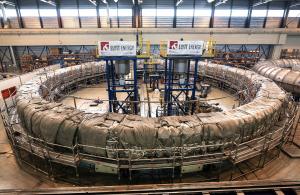In the slow cooker
In the curing process, the resin that was injected in the coil at a temperature of 50 °C is heated to 140 °C by a strong electrical current fed to the conductors (the Joule effect) and by electrical resistances positioned around the mould. Since resin impregnation began for PF4 two weeks ago, staff from the European Domestic Agency Fusion for Energy and its contractors have taken shifts to cover the 24/7 monitoring of the operation.
The mould that contains the impregnated PF4 will be disassembled in mid-August and the coil moved to the assembly station in early September. Following final assembly and cold test operations, the finalized coil should be transferred to the ITER Organization before mid-2023.


